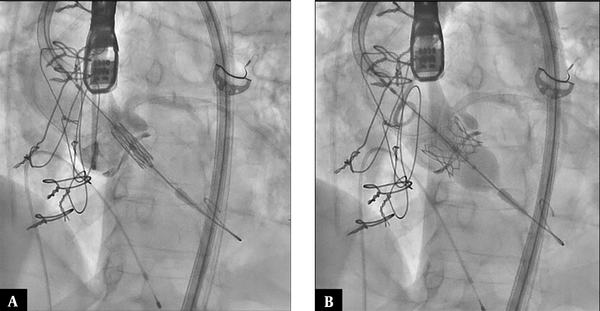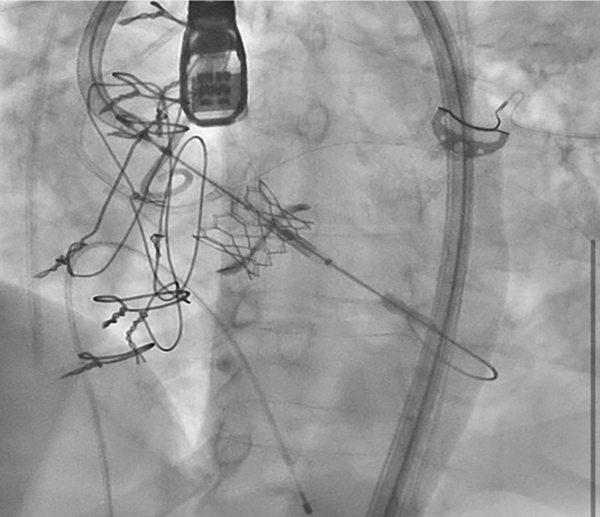1. Introduction
Aortic valve stenosis could be managed favorably by using mechanical or bioprosthetic valves in a process named Surgical Valve Replacement (SAVR), regardless of the extent of the risk factors in patients (1). The main advantages of a bio-prosthesis are the lesser probability of coagulation and, hence, the lesser necessity of using an anticoagulant regimen. However, due to the high levels of fragility, the bioprosthetic valve would need replacement, which can be achieved by either reoperating SAVR or a less invasive method of valve-in-valve SAVR (VIV-SAVR). We herein report a 73-year-old female patient with multiple episodes of heart failure and severe dyspnea who underwent a VIV-SAVR surgery and has demonstrated notably rapid and significant improvements in the postoperative period and follow-ups.
2. Case Presentation
A 73-year-old Caucasian female patient with exertional dyspnea of NYHA function class III-IV and multiple episodes of pulmonary edema within the last 3 months was admitted to Modarres Hospital, Tehran, Iran. The patient had a history of surgical aortic valve replacement (SAVR) with bioprosthetic Mitroflow valve stented 21mm (Sorin Group USA Inc, Arvada, Colo) 10 years prior to admission, along with non-insulin-dependent diabetes mellitus, heart failure, and chronic kidney disease. The echocardiography resulted in the finding of (1) severe left ventricular (LV) dysfunction (ejection fraction = 30%, left ventricular end-diastolic volume (LVEDV) = 135 mL, LVEDV index = 72.9 mi∕m2), and (2) degenerated aortic valve with severe transvalvular aortic regurgitation and mild aortic stenosis (mean gradient = 19 mmHg, peak gradient = 36 mmHg). Moderate mitral regurgitation and mild to moderate tricuspid regurgitation with pulmonary artery pressure of 64 mmHg were also observed on echocardiography. The patient underwent coronary angiography, which demonstrated non-significant stenosis in the middle part of the left anterior descending artery. Our heart team decided to proceed Valve-in-valve transcatheter aortic implantation (ViV-TAVI) procedure because of the high logistic Euroscore (32.76%).
Computed tomography angiography (CTA) of the aorta was considered the standard workup protocol before intervention. CTA showed a distance of the right coronary artery origin to the valve nadir of 11.5 and a distance of the left coronary artery origin to the valve nadir of 11.6. the right, left, and non-coronary sinus of Valsalva diameter were 24.1, 23.2, and 22.4, respectively, and the inner side of the biological valve was measured at 20.5 mm. The bioprosthetic valve of choice for the procedure was Sapien-3 Edwards-20 (Edwards Lifesciences, LLC, Irvine, CA, USA).
We placed a temporary pacemaker in the right ventricle (RV) via the left femoral vein during the procedure. The pigtail 6 Fr catheter was placed in the ascending aorta above the aortic valve through the right radial artery. Access to the left and right femoral artery was achieved by advancing a 6 Fr guide catheter to protect the left coronary artery and to deliver the valve (via a cath-down procedure), respectively. The patient was in deep sedation and intubated status, and vital signs were monitored simultaneously by an on-site intensivist. We found the optimal working view at LAO 23° and cranial 26°. In this imaging position, the previous bioprosthetic valve was perpendicular to the bioprosthetic ring. In the next stage, the prosthetic valve was positioned on the previous Mitroflow bioprosthetic valve strut through an Amplatzer super-stiff guidewire. When the Sapien-3 valve position was adjusted, aortography was performed to ensure the left and right coronary ostia were spared. During rapid ventricular pacing under 3-dimensional transesophageal echocardiography, the bio-prosthetic valve was deployed in the region where the transcatheter heart valve was coaxial with the previous bioprosthetic valve (Figures 1 and 2). Transesophageal echocardiography was the modality of choice for the one-month follow-up of the patient, demonstrating no paravalvular leakage. However, trivial transvalvular regurgitation and mild valve stenosis were observed (mean pressure gradient = 16mmHg, peak pressure gradient = 29 mmHg, acceleration time = 88 msec, and effective orifice area index = 0.7 cm2∕m2).
3. Discussion
Due to the necessity of lifetime anticoagulant therapy in patients with mechanical valves, there is an increasing trend in applying bioprosthetic valves to treat severe aortic valvular disease (2). However, the bioprosthetic valve's main drawback remains the need for reoperation due to structural deterioration of the valve, which had a rate of 5 - 10% (3-5). Alternatively, patients can undergo ViV-TAVI, which has been reported to have a lower 30-day mortality rate and major bleeding rate, lower transfusion rates, lower postoperative ventilation time, shorter ICU stay, and lower acute kidney injury (AKI) rate (1, 6, 7).
Serious complications in patients undergoing transcatheter aortic valve replacement (TAVR) include increased trans-valvular gradient, leakage in para-valvular or trans-valvular, and significant regurgitation (8, 9). Our patient has no paravalvular leakage but revealed trivial transvalvular regurgitation and mild stenosis. Dekany et al. reported the para-valvular regurgitation index as the most prognostic factor in post-TAVR patients who were followed up for 763 days (10). Accordingly, trivial transvalvular regurgitation does not significantly impact survival. Although the transvalvular mean pressure gradient (MPG) and effective orifice area (EOA) after the valve-in-valve TAVR procedure are expected to be 19.5 ± 5 mmHg and 1.17 ± 0.14 cm2, respectively (11), our patient's aortic transvalvular mean gradient was 16 mmHg and EOA 1.3 cm2.
Among other consequences that may occur during the procedure of ViV-SAVR are early and late ostial coronary obstruction, more frequently occurring in the left coronary artery than in the right coronary artery. The prevalence of ostial obstruction has been reported at 3.5% in the literature, and the risk factors are low-lying coronary artery, narrow sino-tubular junction, and internal stent frame such as Mitroflow (12, 13). We protected the left coronary ostium during the procedure using a guidewire. Subsequently, the VTC of both ostia had sufficient length to avoid coronary obstruction (14). Additionally, our patient was hospitalized for 10 days after the procedure to ensure this complication was not observed.
It should be noted that Patients undergoing SAVR procedure are also prone to need of permanent pacemaker implantation, possibly caused by injury of the conduction system (2). It has been reported that the valve-in-valve method causes less invasion to the conduction system than the reoperation, with the result that the pacemaker implantation rate for permanent purposes would decrease substantially.
The most significant observation in this case report is the notably rapid response to therapy. The patient had several hospital admissions due to multiple episodes of acute heart failure for three months before the operation, and dyspnea had been restricting her activity vigorously to such an extent that she had been bedridden most of the time. Following the procedure, the symptoms completely resolved, and the 6-minute walk test showed the ability to walk for approximately 200 meters. At one-month follow-up using echocardiography, our findings showed a 13% increase in LVEF and a reduction in LVEDV during follow-up. Although after valve replacement in severe aortic regurgitation (AR), LVEF and left ventricular remodeling should improve in a more gradual pattern, according to the literature (15).




